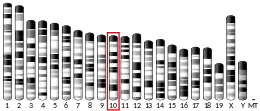TRPM2
Transient receptor potential cation channel, subfamily M, member 2, also known as TRPM2, is a protein that in humans is encoded by the TRPM2 gene.
Structure
The protein encoded by this gene is a non-selective calcium-permeable cation channel and is part of the Transient Receptor Potential ion channel super family. The closest relative is the cold and menthol activated TRPM8 ion channel. While TRPM2 is not cold sensitive it is activated by heat.[5] The TRPM2 ion channel is activated by free intracellular ADP-ribose in synergy with free intracellular calcium.[6] ADP-Ribose is produced to by the enzyme PARP in response to oxidative stress and confers susceptibility to cell death. Several alternatively spliced transcript variants of this gene have been described, but their full-length nature is not known.[7]
Function
The TRPM2 gene is highly expressed in the brain and was implicated by both genetic linkage studies in families[8] and then by case control or trio allelic association studies in the genetic aetiology of bipolar affective disorder (Manic Depression).[9][10]
The physiological role of TRPM2 is not well understood. It was shown to be involved in insulin secretion.[5][11] In the immune cells it mediates parts of the responses to TNF-alpha.[12] A role has been suggested for TRPM2 in activation of NLRP3 inflammasome, the dysregulation of which is strongly associated with a number of auto inflammatory and metabolic diseases, such as gout, obesity and diabetes.[13] In the brain it is involved in the toxicity of amyloid beta, a protein associated with Alzheimer's disease.[14] In 2016, TRPM2 channel was strongly implicated in the detection of non-painful warm stimuli. Chun-Hsiang Tan and Peter McNaughton studied the responses of actual sensory neurons to thermal stimuli, then used an RNA-sequencing strategy to identify TRPM2 as genetically required for warmth detection in the non-noxious range of 33–38 °C.[15]
Clinical significance
TRPM2 expression and function help preserve cancer cell viability.[16] TRPM2 channels are highly expressed in many cancers, notably neuroblastoma.[16]
See also
References
- GRCh38: Ensembl release 89: ENSG00000142185 - Ensembl, May 2017
- GRCm38: Ensembl release 89: ENSMUSG00000009292 - Ensembl, May 2017
- "Human PubMed Reference:". National Center for Biotechnology Information, U.S. National Library of Medicine.
- "Mouse PubMed Reference:". National Center for Biotechnology Information, U.S. National Library of Medicine.
- Togashi K, Hara Y, Tominaga T, Higashi T, Konishi Y, Mori Y, Tominaga M (2006). "TRPM2 activation by cyclic ADP-ribose at body temperature is involved in insulin secretion". The EMBO Journal. 25 (9): 1804–15. doi:10.1038/sj.emboj.7601083. PMC 1456947. PMID 16601673.
- Csanády L, Törocsik B (2009). "Four Ca2+ ions activate TRPM2 channels by binding in deep crevices near the pore but intracellularly of the gate". The Journal of General Physiology. 133 (2): 189–203. doi:10.1085/jgp.200810109. PMC 2638199. PMID 19171771.
- "Entrez Gene: TRPM2 transient receptor potential cation channel, subfamily M, member 2".
- Gurling H (1998). "Chromosome 21 workshop". Psychiatric Genetics. 8 (2): 109–13. doi:10.1097/00041444-199800820-00015. PMID 9686433.
- McQuillin A, Bass NJ, Kalsi G, Lawrence J, Puri V, Choudhury K, Detera-Wadleigh SD, Curtis D, Gurling HM (2006). "Fine mapping of a susceptibility locus for bipolar and genetically related unipolar affective disorders, to a region containing the C21ORF29 and TRPM2 genes on chromosome 21q22.3". Molecular Psychiatry. 11 (2): 134–42. doi:10.1038/sj.mp.4001759. PMID 16205735.
- Xu C, Macciardi F, Li PP, Yoon IS, Cooke RG, Hughes B, Parikh SV, McIntyre RS, Kennedy JL, Warsh JJ (2006). "Association of the putative susceptibility gene, transient receptor potential protein melastatin type 2, with bipolar disorder". American Journal of Medical Genetics. Part B, Neuropsychiatric Genetics. 141B (1): 36–43. doi:10.1002/ajmg.b.30239. PMID 16252251. S2CID 6439507.
- Bari MR, Akbar S, Eweida M, Kühn FJ, Gustafsson AJ, Lückhoff A, Islam MS (2009). "H2O2-induced Ca2+ influx and its inhibition by N-(p-amylcinnamoyl) anthranilic acid in the beta-cells: involvement of TRPM2 channels". Journal of Cellular and Molecular Medicine. 13 (9B): 3260–7. doi:10.1111/j.1582-4934.2009.00737.x. PMC 4516483. PMID 19382906.
- Yamamoto S, Shimizu S, Kiyonaka S, Takahashi N, Wajima T, Hara Y, Negoro T, Hiroi T, Kiuchi Y, Okada T, Kaneko S, Lange I, Fleig A, Penner R, Nishi M, Takeshima H, Mori Y (2008). "TRPM2-mediated Ca2+influx induces chemokine production in monocytes that aggravates inflammatory neutrophil infiltration". Nature Medicine. 14 (7): 738–47. doi:10.1038/nm1758. PMC 2789807. PMID 18542050.
- Zhong Z, Zhai Y, Liang S, Mori Y, Han R, Sutterwala FS, Qiao L (2013). "TRPM2 links oxidative stress to NLRP3 inflammasome activation". Nature Communications. 4: 1611. Bibcode:2013NatCo...4.1611Z. doi:10.1038/ncomms2608. PMC 3605705. PMID 23511475.
- Miller BA (2006). "The role of TRP channels in oxidative stress-induced cell death". The Journal of Membrane Biology. 209 (1): 31–41. doi:10.1007/s00232-005-0839-3. PMID 16685599. S2CID 23311452.
- Tan CH, McNaughton PA (2016). "The TRPM2 ion channel is required for sensitivity to warmth". Nature. 536 (7617): 460–3. Bibcode:2016Natur.536..460T. doi:10.1038/nature19074. PMC 5720344. PMID 27533035.
- Yu P, Cai X, Liang Y, Yang W (2019). "Roles of NAD + and Its Metabolites Regulated Calcium Channels in Cancer". Molecules. 25 (20): 4826. doi:10.3390/molecules25204826. PMC 7587972. PMID 33092205.
Further reading
- Clapham DE, Julius D, Montell C, Schultz G (2005). "International Union of Pharmacology. XLIX. Nomenclature and structure-function relationships of transient receptor potential channels". Pharmacological Reviews. 57 (4): 427–50. doi:10.1124/pr.57.4.6. PMID 16382100. S2CID 17936350.
- Eisfeld J, Lückhoff A (2007). "TRPM2". Handbook of Experimental Pharmacology. 179. pp. 237–52. doi:10.1007/978-3-540-34891-7_14. ISBN 978-3-540-34889-4. PMID 17217061.
External links
- TRPM2+protein,+human at the US National Library of Medicine Medical Subject Headings (MeSH)
This article incorporates text from the United States National Library of Medicine, which is in the public domain.



